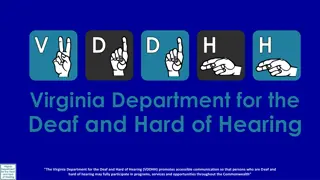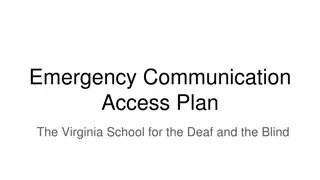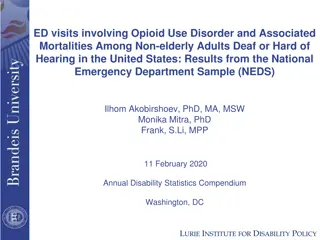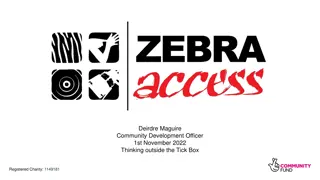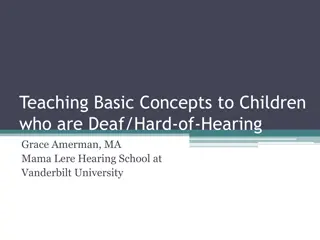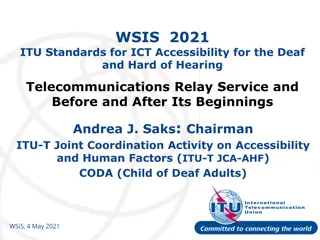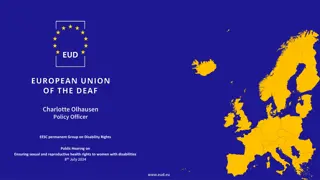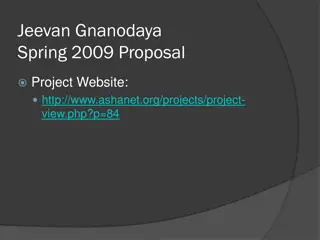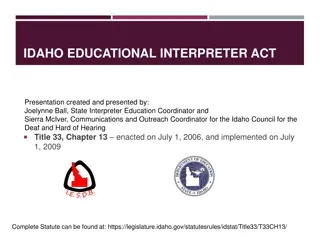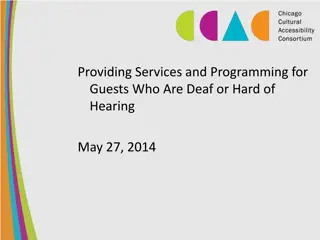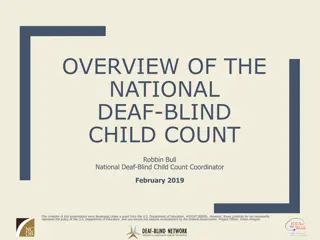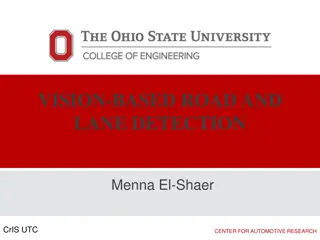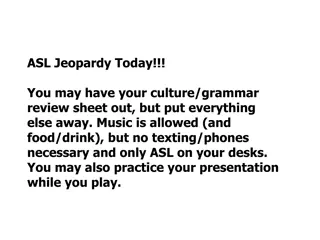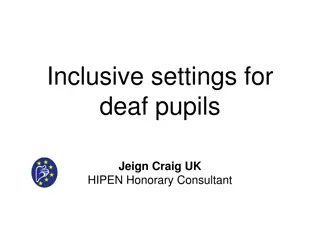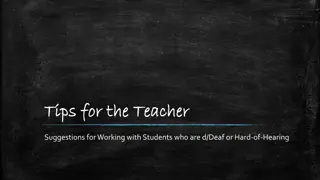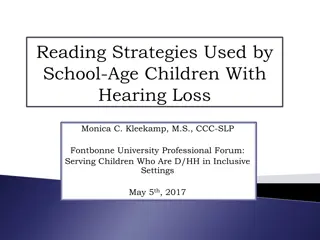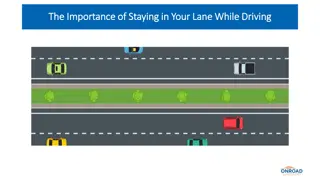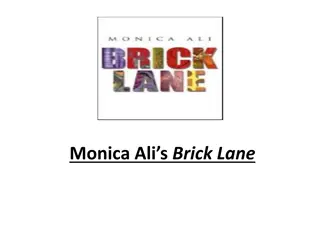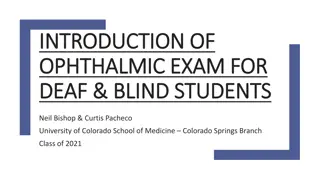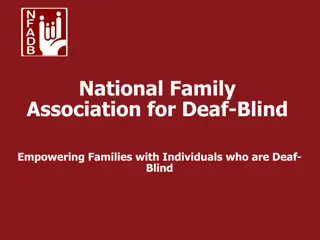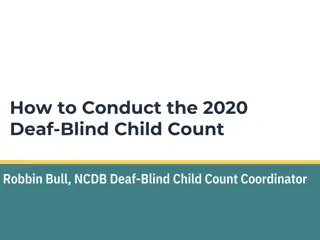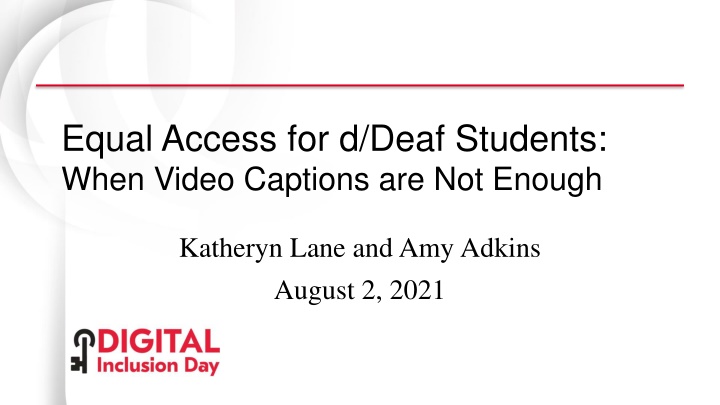
Addressing Challenges Faced by Deaf Students in Online Learning
Explore the unique challenges encountered by Deaf students in hybrid and online learning environments, such as lack of access to Deaf culture understanding, higher multitasking demands, and platform inequities. Learn about the importance of dual accommodations, interpreters, and speech-to-text services in facilitating effective communication for Deaf students.
Download Presentation

Please find below an Image/Link to download the presentation.
The content on the website is provided AS IS for your information and personal use only. It may not be sold, licensed, or shared on other websites without obtaining consent from the author. If you encounter any issues during the download, it is possible that the publisher has removed the file from their server.
You are allowed to download the files provided on this website for personal or commercial use, subject to the condition that they are used lawfully. All files are the property of their respective owners.
The content on the website is provided AS IS for your information and personal use only. It may not be sold, licensed, or shared on other websites without obtaining consent from the author.
E N D
Presentation Transcript
Equal Access for d/Deaf Students: When Video Captions are Not Enough Katheryn Lane and Amy Adkins August 2, 2021
Outline Challenges faced by Deaf students in online learning Dual accommodations Interpreters and speech-to-text services Sign language interpretation of pre-recorded media Implementation of services
Learning Objectives Identify unique challenges faced by Deaf students in hybrid and online instruction Explain effective communication as defined by the DOJ Describe situations for which dual accommodations, interpreters and speech-to-text services, are appropriate
Dear Hearing People View of a young dark haired girl, perhaps six or seven years old, gazing up wistfully. Text over her reads Dear Hearing People.
Challenges faced by d/Deaf students in online and hybrid instruction
Barriers Lack of understanding of d/Deaf culture and communication differences Higher multitasking demands on Deaf students Platform differences and requirements Inequitable access
Implications During COVID Major adjustments for students who prefer face-to-face learning in classrooms and with tutoring Changes in accommodation needs Departure from best practices with lengthier videos and heavier content Increased demands for communication access services
Background The total number of media minutes captioned for disability accommodations increased by more than 396% in FY 2020-21 Interpreting service hours increased by 47% during FY2020/2021 99% of all interpreted hours were provided remotely to accommodate hybrid and online course instruction. 20% of all interpretating service hours covered pre-recorded media exclusively. Prior to FY2020/2021 we provided interpretation for online courses at less than 1%.
Dual accommodations interpreters and speech-to-text services
NAD SUES WHITE HOUSE (Sign1News) Deaf and hard-of-hearing people are affected by the pandemic, just like everyone else, but we re not getting the same access to information, resources, and updates as others. Accurate captioning helps anyone and everyone. Appropriately assigned interpreters at press briefings avoids possible misunderstandings. - Howard A. Rosenblum, NAD chief executive
Appropriate Accommodation Situations for individual students Technical and complex content High stakes events Supplemental services Multiple deaf or hard of hearing students
Effective Communication (DOJ) Effective communication is communication with individuals who are deaf that is equitable to communication with persons without hearing loss Use of auxiliary aids and services Key consideration to nature, length, complexity, context, and normal methods of communication Primary consideration to the choice of aid or service requested Equally effective
Reasonable Accommodation Sign language interpretation of pre-recorded media as a reasonable accommodation within the scope of ADA regulations and WCAG standards Americans with Disabilities Act (ADA) regulations Alignment with Web Content Accessibility Guidelines (WCAG) standards
Importance of Offering Reduces barriers Equitable learning experience Engagement and partnerships Faculty development opportunity
Student Feedback "Interpreted videos are really nice, I can review information I may not otherwise understand. It's easy to follow along. The only struggle is that there is no interaction to clarify if I don't understand something. Without video interpretation, I would be completely lost in my courses."
Sign language interpretation of pre-recorded media, implementation of services
Current Workflow Partnership Workflow Early communication Planning meeting Process Feedback Student Accessibility Resources Communication Access Team Faculty Constituents
Early Communication Schedule planning meeting Access to Canvas course Accessibility Resources Specialist role Course audit Survey of course structure
Planning Meeting Communication and Collaboration Communication channel Timeline Roles and responsibilities Planning equitable access to content Same time Same place Equally effective mode
Process & Feedback Process Captioning Interpreting Availability, same time, same place Feedback Planning meeting Teams channel End of semester survey
Faculty Feedback "I am very impressed with the turnaround of the final product. On my end, I'm very pleased with everything." "I think the process of ASL and captioning the videos was pretty streamlined and easy to accomplish on my end. It was a bit of pressure to make sure that I had the whole semester's worth of videos completed up front."
Lessons Learned Collaboration Support and plan of action Clear responsibilities Frequent communication Flexibility
Best Practices For delivering communication access services Establish systems and protocols Utilize quality service providers Ensure effective service delivery Provide channels for feedback and ideas Be flexible, be prepared, start early
Next Steps Continue to vet this process in the fall Explore sharing options for course audits Develop a tracking protocol Develop shared resources Introduce a ticketing system
Reference Links Dear Hearing People (video) NAD Sues White House NDC Dual Accommodations Effective Communication (DOJ) Understanding Laws and Regulations (NDC) Web Content Accessibility Guidelines (WCAG) 2.1 NDC Foundations of Effective Accommodations (e-learning course)
Contact Information Amy Adkins ASL/English Interpreter adkinam@ucmail.uc.edu Katheryn Lane Electronic & Digital Accessibility Specialist lanek7@ucmail.uc.edu

